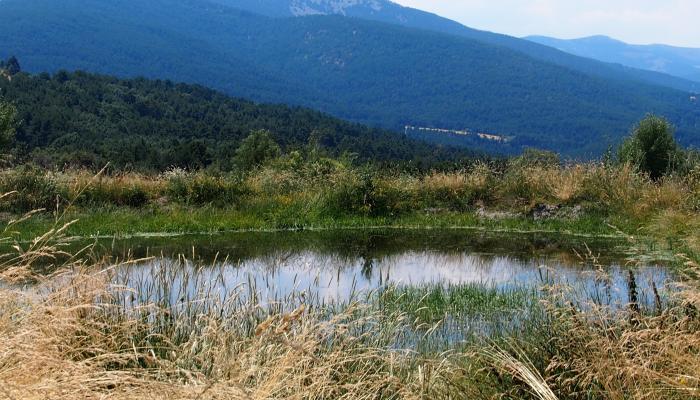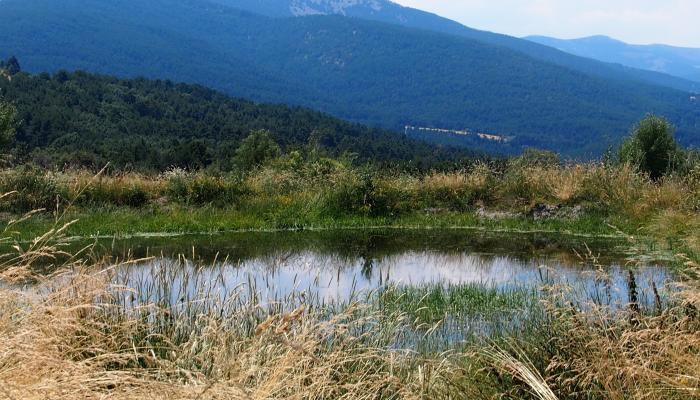
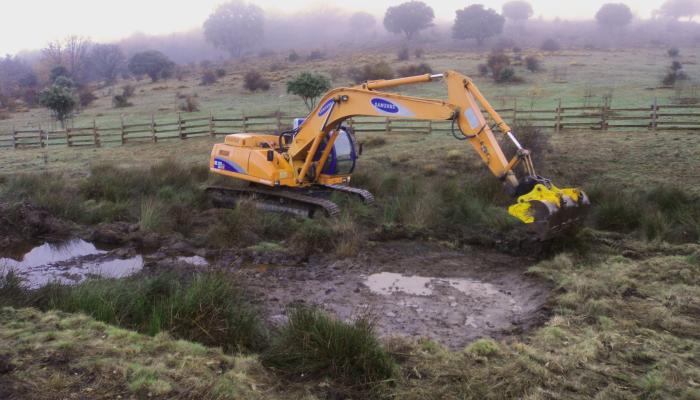
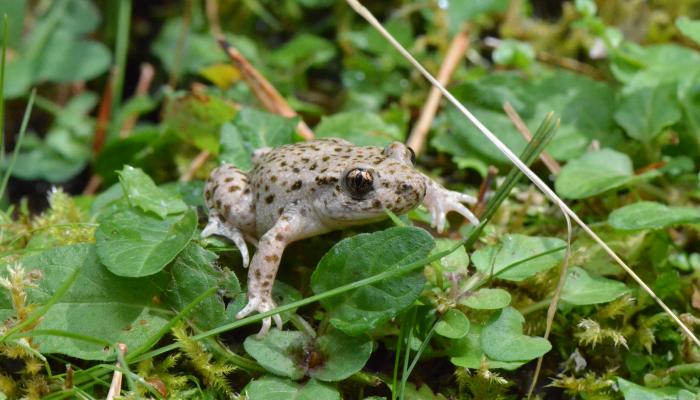
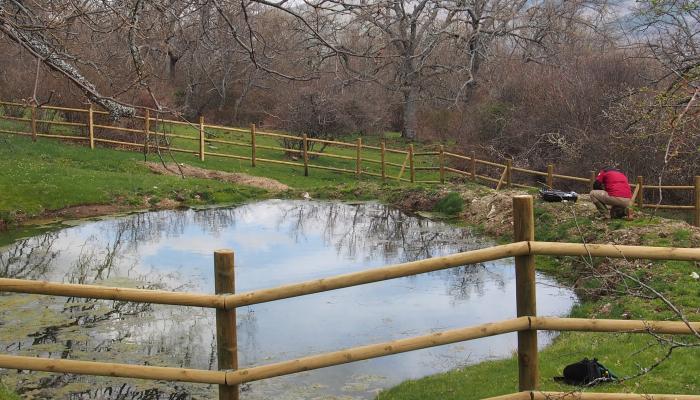
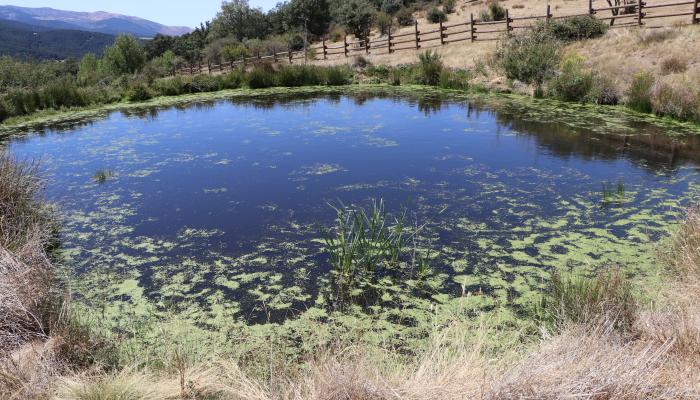
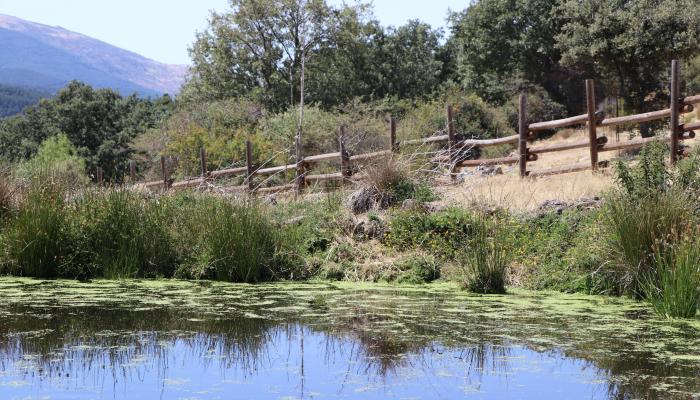
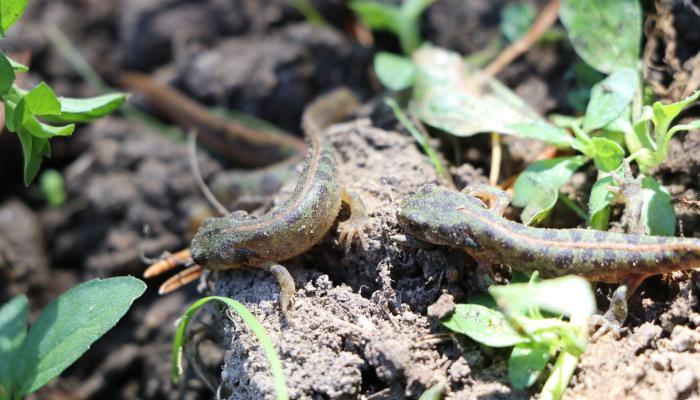
Amphibians suffer a global decline. This has made them the most threatened group of vertebrates on the planet, with more than a third of the species under some degree of threat. The main threats include the destruction of their habitat, changes in climate, emerging diseases and the disappearance of places of reproduction. This project consists in an intervention for the conservation and improvement of the populations of the eleven species of amphibians inhabiting the Montes de Valsaín Mountain Range (Segovia) through a series of undertakings to protect the ponds already existing in the area and to create new spaces suitable for the reproduction of different species.
The Montes de Valsaín mountain range is located on the northern slope of the Sierra de Guadarrama, in the municipality of the Real Sitio de San Ildefonso. They constitute a forest area of 10,668 ha and are State-owned Public Utility Forests, managed by the National Parks Autonomous Organization (OAPN) through the Centro Montes y Aserradero de Valsaín.
It is a well-preserved area that gathers several protective attributes, including among others: Natural Site of National Interest - declared as early as 1930 -, Special Protection Area for Birds (ZEPA), Special Conservation Zone (ZEC) and Natural Park and Biosphere Reserve. In addition, since 2013, 3,326 ha of the Montes de Valsaín mountain range have been incorporated into the Sierra de Guadarrama National Park and another 7,011 ha have been included within the Peripheral Protection Zone as a Special Protection Area of the National Park, obtaining a similar legal regime to that of the National Park.
In the area, Albar pine trees (Pinus sylvestris) and Pyrenean oak (Quercus pyrenaica) groves predominate. Broom, creeping juniper and high mountain grasslands can be found at higher elevations.
One of the lines of work of the Conservation and Monitoring Area of the Montes de Valsaín Center is to contribute to the conservation and recovery of the amphibian communities that inhabit the area, one of the groups most affected by climate change and the resulting modifications in both habitat and ecosystems. Amphibians are closely linked to aquatic ecosystems and, in particular, to the existence of permanent or temporary ponds where they can lay their eggs and complete full metamorphosis toward adulthood.
Thus, the survival of amphibian populations depends directly -among other variables - on the existence of water surfaces, whose viability is being highly compromised locally, regionally and globally, due to the lower precipitation and higher temperatures linked to climate change. In addition, the loss and fragmentation of habitats and the onset of new diseases (caused by viruses, bacteria and fungi) are seriously contributing to the decline of amphibian communities throughout the world.
The results obtained from the Amphibian Monitoring works carried out at the Montes de Valsaín Center indicated the need to establish zones that favor the reproduction and mobility of these species, avoiding as much as possible the mortality of both adults and larvae.
Conservation and improvement of the populations belonging to the eleven species of amphibians that inhabit the Montes de Valsaín mountain range (Segovia) through a series of actions aimed at protecting the ponds already existing in the area – through fencing fundamentally - and creating new suitable spaces for the reproduction of the different species - excavations on the ground that could act naturally as new pools and fencing thereof.
- Improvement of the availability of aquatic habitats and thereby improve the diversity of plant and wildlife associated therewith.
- Favor other wild species not directly linked to these aquatic environments, but which do use them to drink.
A few years ago it was decided to initiate an intervention project for the conservation and improvement of the populations of the eleven species of amphibians that inhabit the Montes de Valsaín mountain range: salamander (Salamandra salamandra), Iberian ribbed newt (Pleurodeles waltl), marbled newt (Triturus marmoratus), common toad (Bufo spinosus), Natterjack toad (Epidalea calamita), common midwife toad (Alytes obstetricans), Iberian spadefoot toad (Pelobates cultripes), Iberian painted frog (Discoglossus galganoi), common frog (Pelophylax perezi), Iberian frog (Rana iberica) and San Anton frog (Hyla molleri). The project began with the diagnosis of the baseline situation and the specific reproduction requirements that each of the species had, as a starting point from which to develop a series of actions to protect the ponds already existing in the area - through fencing fundamentally - and to create new spaces suitable for the reproduction of different species - excavations on the ground that could act naturally as new pools and fencing thereof.
In some cases, it entailed recovering spaces that had been lost due to lack of use, as is the case of some ponds that were used to provide livestock with drinking water and that have become clogged due to lack of maintenance work. In others, it entailed adapting places that are good for amphibians and which require certain undertakings such as fencing, to avoid trampling by livestock and to provide refuge areas. In addition, new pools are created in places suitable for amphibians, but which lack a habitat for their reproduction.
Wet areas of different dimensions have been created using a wheeled backhoe to prevent damaging the surrounding areas. Depths have varied according to the zones, with an average of 1.5 m and adapting to the terrain to avoid large earth movements. The excavated earth was dumped on the sides of the excavation in order to increase the capacity; slopes were smoothened out so that the final result is as natural as possible, and vegetation settles itself on them, fixing them into place. Water evacuation pipes operating from one level were installed, preventing the water from overflowing and damaging the retaining structure.
Enclosures with treated wooden posts have also been installed to avoid damages caused by trampling and overgrazing by livestock, with the resulting damage to amphibians. Fences are permeable for wildlife.
The interventions do not include the relocation or transfer of animals from one pond to another. Thus, colonization by different species (not only amphibians, also plants and other animals) is absolutely natural.
Together with these in situ conservation measures, an ex situ conservation measure has been launched by the Montes de Valsaín Center. The intervention consists in removing the larvae of amphibians which, as a result of the early drying of the ponds due to the increase in temperature and variations in the distribution of precipitation, would die due to their inability to complete metamorphosis, and transferring them to suitable facilities where they can complete the cycle and become adults. Later, they are relocated again to their original habitats, thus reinforcing the populations. In no case are specimens that could be naturally viable removed from the land and so far, no artificial recolonizations are carried out in places other than those from which the larvae were extracted.
The Montes de Valsaín mountain range is located in the northern slope of the Sierra de Guadarrama and are Mountains of Public Utility (Mountains 1 and 2 of the CUP of the province of Segovia), owned by the State and managed by the National Parks Autonomous Organization through the Montes and Aserradero de Valsaín Center, where the Plant and Wildlife Conservation and Monitoring Area responsible for the project works.
Interpretive signs describing this undertaking and the problem it faces have been installed in the vicinity of the works. These panels provide information on the purpose of these works, raising awareness of the consequences that climate change can bring, particularly in the case of amphibians and their vulnerability.
As an added component to the work carried out, these actions have been endowed with an informative component. To this end, various materials have been developed that are available on the OAPN website. The materials produced are aimed at a wide variety of target audiences, ranging from more technical information collected in a book featuring photographic reports of the works, to knowledge and awareness materials aimed at children, to other informative elements such as guide to the types of amphibians present in the National Parks Network or a dichotomous key that allows their identification without the need to manipulate the observed specimens.
It is a type of undertakings that is not very demanding in terms of economic and technical resources, making replication in other locations relatively simple. In the case of Valsaín, both the National Parks Autonomous Organization's own resources and funds from the Environmental Promotion Plans (PIMA ADAPTA) have been used.
It is a type of undertakings that is not very demanding in terms of economic and technical resources, making replication in other locations relatively simple.
Initial data in Valsaín point to a considerable success of the interventions carried out to date, with a rapid natural colonization of the ponds by the amphibian species existing in the area.
One of the most complex aspects of the project is the definition of those places on which to intervene, which should be suitable for the formation of new ponds due to both their spatial location and the natural impermeability of the ground, since neither concrete nor plastics are used nor any type of artificial material. When the ground is not completely impermeable in the baseline situation, the progressive accumulation of organic matter helps to achieve this over time.
A key element of the project is the monitoring and evaluation of the results - in this case, the amphibian populations in the different ponds - to which special attention and effort is paid. In this sense, it is very important to know that very high inter-annual variability exists in amphibian communities, which requires long periods of time in order to ascertain the population trends of the different species in the different places with a certain degree of rigor.
Budget financed through the PIMA-Adapta Plan of the Spanish Office of Climate Change (OECC) assigned to the OAPN for this specific purpose. In general, these are not actions involving high monetary amounts, which include: the cost of obtaining prior knowledge about the species, its requirements and threats; protective fencing; manual or mechanical excavation of a flood zone (if applicable); monitoring and control of the evolution of populations and the maintenance of the sheet of water in the built ponds, carried out by expert personnel; and in situ signage (where appropriate).
The first data in Valsaín point to a very considerable success of the interventions carried out to date, with a rapid natural colonization of the ponds by the amphibian species existing in the area. And not only amphibians, but also a wide range of plant and wildlife species have made these spaces their own and have contributed to convert them into valuable habitats. In addition, the ponds are used as drinking troughs by mammals and birds, having become authentic oases in times of low water availability.
The area of intervention is a well-preserved area that gathers several protective attributes, including among others: Natural Site of National Interest - declared as early as 1930 -, Special Protection Area for Birds (ZEPA), Special Conservation Zone (ZEC), Natural Park and Biosphere Reserve. In addition, since 2013, 3,326 ha of the Montes de Valsaín mountain range have been incorporated into the Sierra de Guadarrama National Park and another 7,011 ha have been included within the Peripheral Protection Zone as a Special Protection Area of the National Park, obtaining a similar legal regime to that of the National Park.
These actions are part of the Natural Resources Management Plan (PORN) of the Sierra de Guadarrama National Park.
2015-2018
Plan de Impulso al Medio Ambiente para la Adaptación al Cambio Climático en España (PIMA ADAPTA) 2015. Actuaciones para la mejora de hábitats de anfibios y de gestión forestal adaptativa en el Parque Nacional de Cabañeros, en el Centro de Montes y Aserradero de Valsaín y en las fincas del OAPN Dehesa de San Juan (Parque Nacional de Sierra Nevada) y Lugar Nuevo (Parque Nacional de Monfragüe).http://www.mapama.gob.es/es/red-parques-nacionales/red-seguimiento/pima-adapta/libroactuacionespimamontesvalsain_tcm30-61791.pdf
Marisol Redondo
Centro Montes y Aserradero de Valsaín. OAPN.
C/ Primera, 11. Pradera de Navalhorno. Valsaín. San Ildefonso-La Granja. 40109. Segovia
Correo electrónico: sredondo@oapn.es



